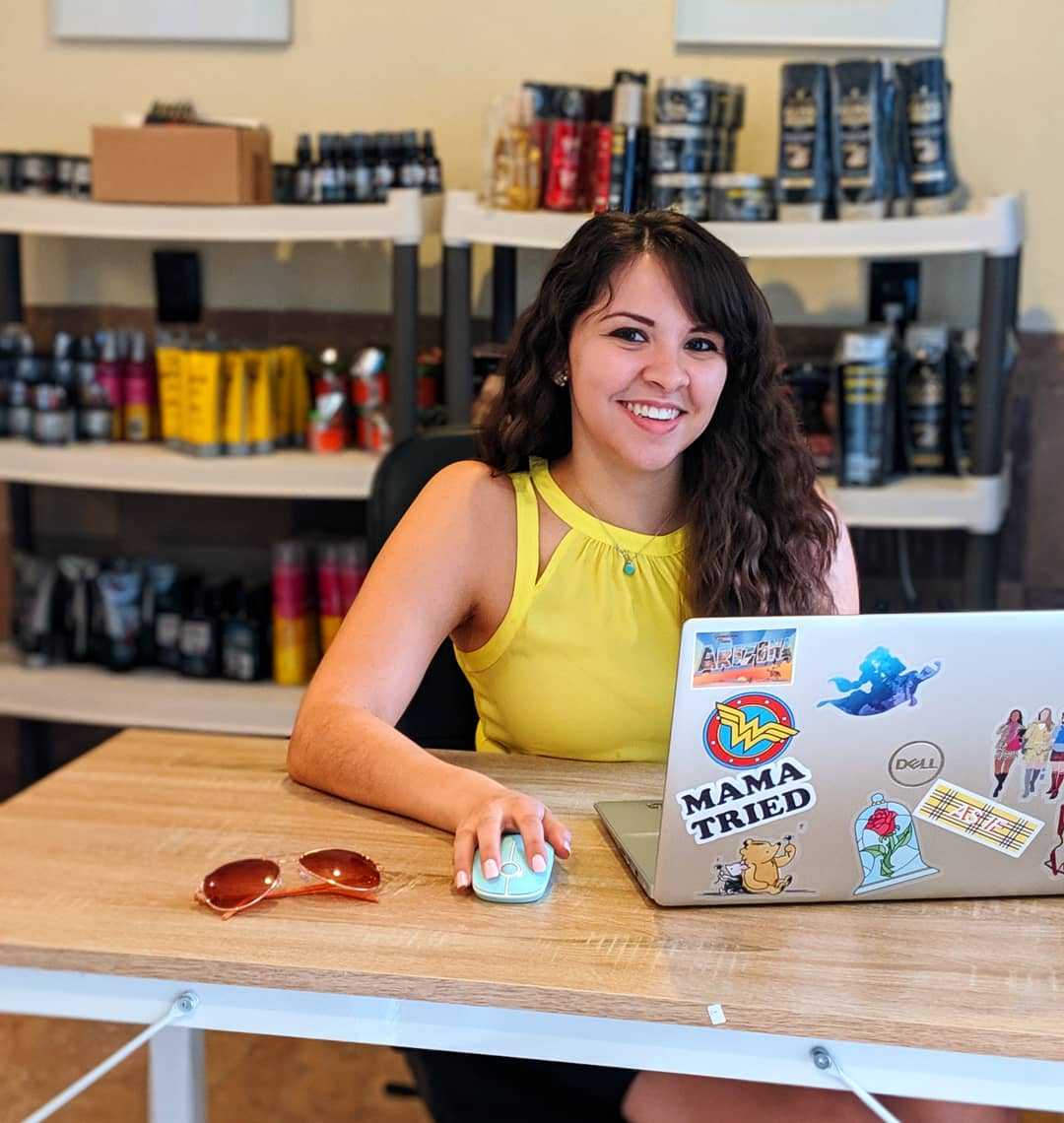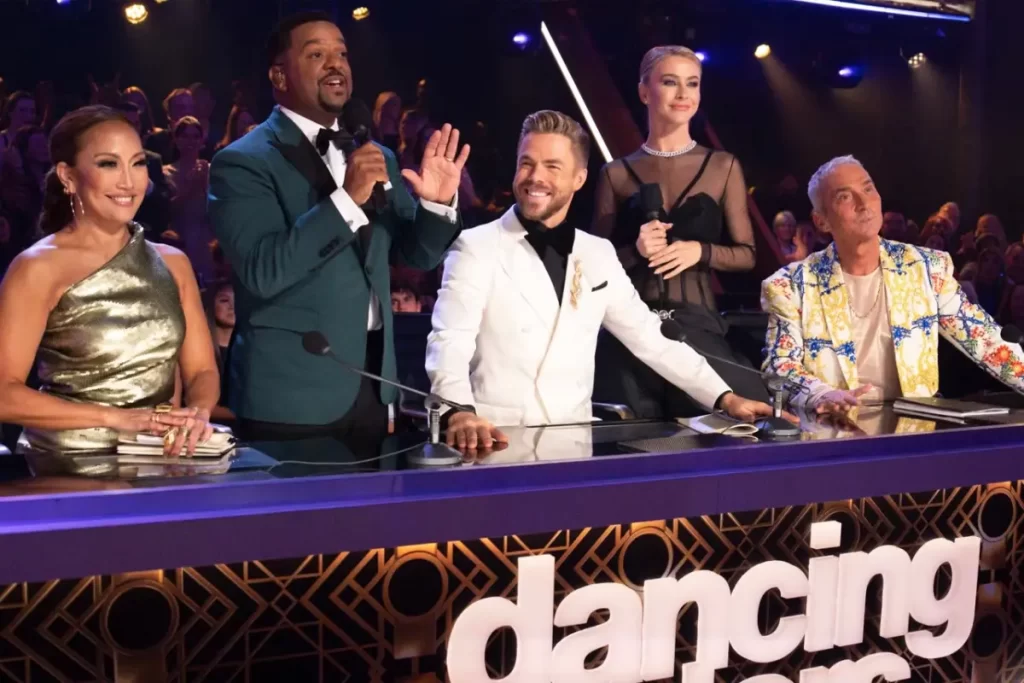By: Karina Griffin
This is a blog written by Nativa’s intern, Karina Griffin, about her experience growing up Latina in a predominantly white world and how she came to understand her dual heritage.
——————-
We live in a colorful world. Growing up, we learn about colors. We learn about primary colors: red, blue, and yellow. We then learn about secondary colors: purple, green, and orange. Tertiary colors are the ones between primary and secondary colors where they have a little bit more of one primary color than the other. In American History, we learn about black and white. Outside of the classroom, however, colors are more complex than what we are taught.
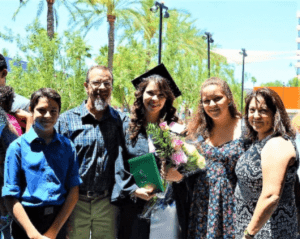
Growing up, I did not know that being Mexican made me different. I also didn’t know that my Mexican heritage was not apparent just by looking at me. I grew up in Mesa, a suburb 30 minutes East of Phoenix, in a mixed family. My mother was a Mexican immigrant, who’s family came to the United States when she was only 3-months-old and she grew up in Kansas. My dad was born in Indiana to an Irish-Polish-and-who-knows-what-else family and grew up in Arizona. My maternal grandma and grandpa spoke English but with a funny accent and at times sounded very broken. My paternal grandparents were your average American divorcees. To me, they were all just my family. People say that little kids don’t see color, and I guess that’s true.
I began dancing at 3-years-old. I never felt different from the other girls; we were all in pink tights and black leotards learning the same things. When I started school, I went to a Catholic elementary school from kindergarten to fourth grade. My class was always diverse and one year we even celebrated cultural heritage week. I thought everyone came from different places, based on our presentations so, I still didn’t feel different. It wasn’t until fifth grade, when I moved from my Catholic school to the local public school, that I started to feel different. I felt a little blue leaving my “friends” from my first school (you’ll understand those quotes in a moment). Not only did I have to go through the awkwardness of being the new girl, but I was also, very apparently, going through puberty and on the verge of developing the classic “Latina” figure. I’m an outgoing person so it wasn’t hard to make friends and find my place. I still felt normal. But as you mature, you start to understand news headlines and what they mean for society. And boy, did I get hit with a big one in fifth grade.
In the middle of the school year, my home state of Arizona came under fire for racial profiling under Sheriff Joe Arpaio. These racial profiling incidents were all targeting Mexicans (both Mexican Nationals and Mexican Americans) and I became familiar with the terms “illegal immigrant” and “green card”. I learned that prejudices existed against Mexicans and that they were thought of as criminals and drug dealers, amongst other stereotypes. I didn’t understand what this all meant for me as a Mexican-American. I started to become very uneasy, even green at times. My mom assured me that everything was going to be okay and that there are just racist, mean people in the U.S. that think Mexicans are taking ‘their’ jobs. But because I can pass for white, my new friends didn’t know that I was Mexican because it just wasn’t apparent. I wasn’t treated any differently by my friends, despite the negative headlines that I was seeing.
This all changed one day in computer class. I realized I wasn’t the only one in my class seeing these headlines. I was sitting next to my best friend and I was telling her about my cousin’s quinceañera. She asked what that was, and I told her that it was a big party, the size of a wedding, and it was kind of like a Mexican Sweet Sixteen. She asked me with a look of not only confusion but concern, “Are you Mexican…?” My stomach dropped. I told her, nervously, “Yeah, I’m half.” and I could tell that she wasn’t sure how to process this information. She looked at me, and I could see the twinge of fear in her eyes as she simply said, “Oh, okay.” and turned back to her work on the computer. I must have turned a new shade of red.
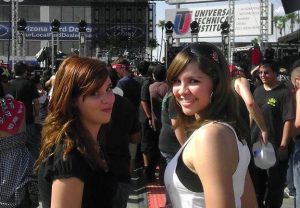
That moment changed my life. I had never felt that way before. I had been bullied at my Catholic school before for my glasses, my braces, my being taller than everyone, and even for starting puberty before everyone. I considered those bullies my friends and took the emotional beating from my “friends”. But at this moment, my heart felt like it had been bruised purple; I had never felt the hurt that this moment brought on. I didn’t cry—I was too confused to cry. For the first time in my life, I felt truly discriminated. What can you do in that kind of situation? This moment is still so vivid and ingrained in my memory 10 years after it happened.
Luckily, that was near the end of the school day and I got to go home. I don’t remember what happened at home that night and who knows what kind of conversation my friend had with her parents that night, but the next morning, my friend acted as if nothing had happened. We went about our day as usual and I felt accepted, despite her learning about my true identity the day prior, and I was so relieved. I began to accept that I was different and that it was okay. Fifth grade passed and I moved to my third and final school, a prep school that served 6th to 12th grade. I went on and decided I would be myself and see where it took me, knowing that I might be different because I was Latina. Through the course of junior high, I talked about quinceañera planning with my closest friends and they were beyond supportive and orange with excitement.
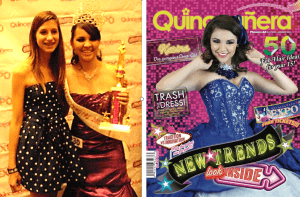
Right: Karina on the cover of Quinceañera Magazine.
As my 15th birthday grew nearer and my family was in the heat of planning the celebration, my madre and I saw an opportunity for me to model for Quinceañera magazine and we took it! I loved being on stage and this was no different. After I trained and participated in the Quinceañera Expo, the directors urged me to participate in the Miss Covergirl Pageant. During both of these experiences, I realized that I had only had a handful of Mexican friends in the past and I started making new ones. The problem with these new friends was that I still didn’t feel like I fit in and that confused me even more. “They’re Latina and I’m Latina,’ I thought, ‘why don’t I feel like I fit in?” To them, I was the guera, or the gringa, or plainly as ‘the white girl’. I lived on the east side of the Phoenix metropolitan area and most of them lived on the west side, which is traditionally much more Hispanic. But, nevertheless, I tried to fit in and I made a lot of new friends. I will never forget the day of the pageant, one of my non-Mexican friends from school came to support me. Every time I was on stage, I could see her and my grandmother from my dad’s side leaning over to my mom to understand the Spanish and ask what was going on. When the MC called my name as a winner, no translation was necessary. I guess excitement is a universal language.
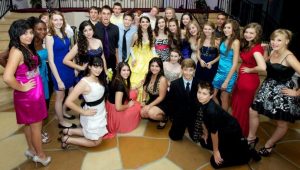
I became more active in the Latino community after I won the crown. I began actively learning Spanish in high school when I started my Freshman year that August because at that point, I needed to be able to communicate with the magazine’s various vendors with whom I constantly worked. My quinceañera came and passed, surrounded by my friends and family of all colors. I was yellow with happiness (get it? My dress was yellow!). And high school was a breeze! Besides convincing the school to change the date for homecoming to accommodate my quinceañera, I really felt like there was nothing to worry about. That ordeal almost made me even cooler. I look back on high school fondly. I had a wide variety of friends, I went through all of the emotions, I was grey with stress at times (even earning my first grey hair while working on my senior thesis). But that’s high school!
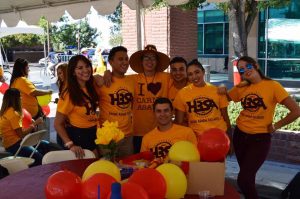
I started college at Arizona State University (ASU) in the Fall of 2016. I immediately joined the Hispanic Business Students Association (HBSA). My mom encouraged me to get involved and make lifelong friends and familia like she had done when she was in HBSA years before. You know those tios and tias you have that you’re not actually related to at all? I have those too and HBSA is where my mom had met them. ASU is the most colorful and diverse school I have ever attended. And even though I was making many friends in classes and HBSA, I started to feel like an outsider again. We were all ‘brown’ but most of my HBSA friends were 100% Latino whereas I was 50% white. I like to say that Latinos are like café con leche; some coffee is taken black while some coffee has more milk mixed into it. I did not face all of the challenges that my HBSA friends did in growing up and going to a university. I was not a first-generation college student like many of them were. I did not have to be the first in my family to learn English. I did not have to cross the border for a better life. And it was not until my second year when I met another half-Mexican guy that passed for white in HBSA that I realized that my HBSA friends treated us a little differently than they treated each other. They grew up in very different households and families than we did. They switched to speaking in English when we would join a group. They spoke to us in almost a more respectful manner. They didn’t talk about the same things when we were around. They used more slang when we weren’t around and they would talk about the crazy things they did with their cousins that weekend but change the subject to discussion about classes or HBSA related activities when we walked up.
There is no exact explanation for why this difference in treatment occurs. Maybe they were taught to be respectful to white people. Maybe they had never had white friends. Maybe they had feared white people reporting and deporting them or their families. Maybe they felt that we didn’t understand what being a minority felt like. Maybe they felt like we weren’t fluent in Spanish and were just trying to be helpful. Maybe they didn’t think that we had ever felt discriminated against. It’s clear that this different treatment was unintentional. It came from deep in their subconscious.
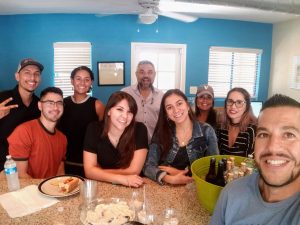
And my Latinx friends may continue to feel discriminated against when they go into the workforce in the future, being hired to fill a diversity quota and not being appreciated for the talent they actually bring to the table. In conversations with them, sometimes I feel that they are a little green with envy when they jokingly say, ”Your last name is White so you won’t be hired to fill a quota or be put into a Hispanic-oriented position.” I really don’t think I will ever fully understand the level of discrimination that they have lived with throughout their lives. However, I have lived with my own discrimination, on both sides of the racial divide. I also have feared pigeon-holing myself into a Hispanic-oriented position. I was even hesitant to take my current internship at Nativa because it was just that; a Hispanic-oriented internship.
Despite my hesitation, I am currently finishing up my internship with Nativa, a Multicultural Marketing Agency. I have learned so much about the marketing/advertising industry through this internship. I do not feel like I will be stuck working in the Hispanic market forever, but I’m glad I did. I look forward to my future as I finish my final year at Arizona State University and move on towards my career in marketing. Over the years, I’ve learned to be a proud Latina, to be an outgoing person, to accept and enjoy the colorful world around me, to have empathy for others, to never judge someone without knowing their story, to explore new opportunities, and above all, to be, unapologetically, myself.
